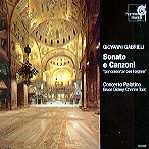This release of sonatas and canzonas by Giovanni Gabrieli is the realization of what many others have attempted–to faithfully capture the unique sound, spatial orientation, and consequent physical sensation inherent in Gabrieli’s carefully constructed harmonic frameworks, released through the timbres of brass, strings, and organ. These performances are a marvel of sonority and virtuosity and ensemble unity–just what this music is all about–and the sound engineering simply blows all competitors out of the cathedral. Of course, the effective recreation of this sound world depends as much on the performing space (with an emphasis on the word “space”) as on the notes and instruments. Gabrieli enjoyed the incredibly agreeable acoustics and favorable physical setup of Venice’s St. Mark’s basilica, for which he wrote these pieces, and recordings of his music have been made there–notably the 1967 effort by The Gregg Smith Singers, organist E. Power Biggs, the Gabrieli Consort, and many others, for Columbia records–but the two famed organs on which the composer played and for which he wrote have not survived. These highly regarded instruments were set facing each other and served both as centerpieces and foundations for his St. Mark’s works, which also included cornetti, violins, and trombones.
Accepting that today’s St. Mark’s wouldn’t do, the producers of this recording set to finding a similar cathedral with the two requisite organs. Incredibly, they found one–the Basilica of San Petronio in Bologna–and it’s a gem, as suitable for this music as modern ears can imagine. The performances by Concerto Palatino are splendid, and we can hear detail of individual solo instruments, brilliant brass licks, and sumptuous, resonating chords with equal clarity and naturalness. I counted an 11-second sound decay, which is allowed to ring at the end of each track, and the effect is further enhanced by the very good separation in antiphonal sections. This is a remarkable achievement on all counts, and you shouldn’t miss it.
































